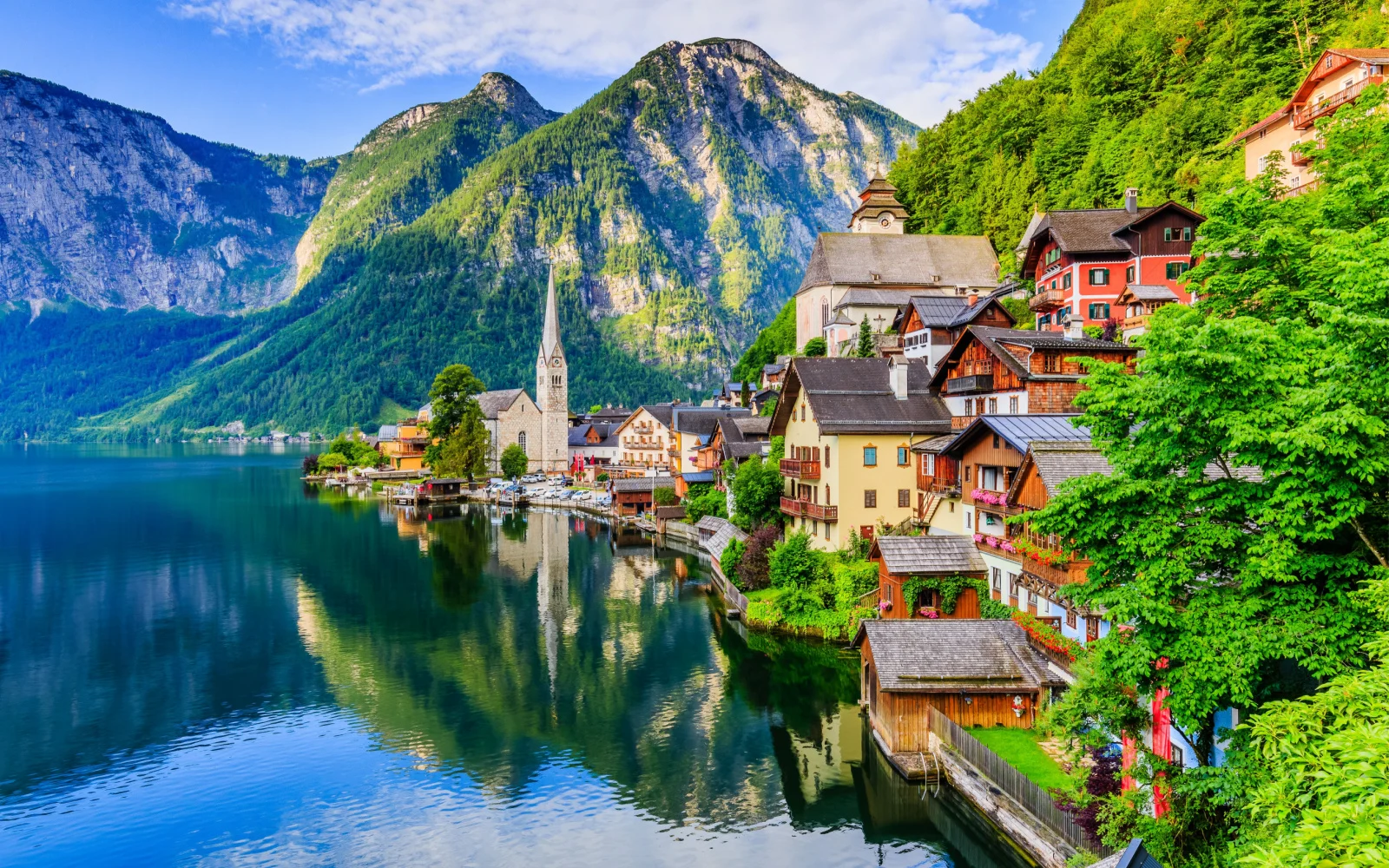What's the best time to visit Austria?
The best time to visit Austria is in summer (June-August) when the weather is warm, averaging 71°F, and major festivals like the Salzburger Festspiele take place. This season is perfect for exploring cities and hiking in the Alps, despite higher hotel rates and busier attractions. Summer is Austria’s peak season, filled with vibrant festivities, tours, and other outdoor activities.
Planning a trip to Austria soon? A visit is always a good idea to this amazing country, which has something for everyone, from bustling metropolises to beautiful mountains. Austria’s capital, Vienna, is packed with history and world-class museums—plus some great restaurants and modern galleries as well.
Head west to visit the Alps and take in picturesque villages such as Hallstatt. Fans of Mozart (and The Sound of Music) should head to Salzburg.
The country has a lot to offer, especially if you visit during the best season for exploring. Keep reading to find out about the best time to visit Austria, when you can save some money on your trip, and other tips. Let us be your guide!
Overall Best Time to Visit Austria
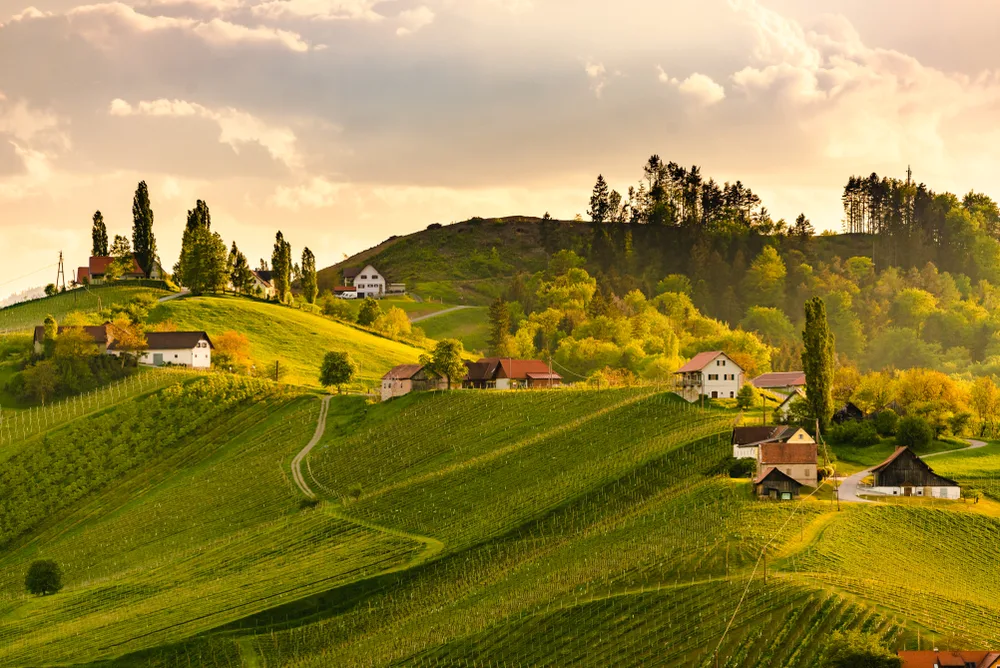
Przemek Iciak/Shutterstock
The best time to visit Austria is the summer (June-August), when the best festivals are happening in the country and when the weather is gloriously beautiful. Austria has a temperate climate, and high in the Alps it has an alpine, or mountainous, climate.
This means that the country has four distinct seasons, and in mountainous regions the weather tends to be cooler with longer winters and more snow.
Summers in Austria can get pretty warm. Average high temperatures in the entire country in July are about 22 degrees Celsius (71 degrees Fahrenheit). Even high in the mountains, you’ll be able to do a lot of your hiking in just a T-shirt.
In low-lying areas such as Vienna, summers can get even warmer, with temperatures around 80 degrees Fahrenheit. Summer heat waves are becoming more and more common, with temperatures going over 90 degrees Fahrenheit.
However, these extreme heat days are not so common in Vienna, so most summer days are just pleasantly warm. This weather is perfect for exploring outdoors, whether you’re walking around a pretty city or exploring some of Austria’s gorgeous nature.
During summer, many locals use the season as an opportunity to get outside and explore the countryside. This is a great time to explore regions such as the Salzburg Lake District, where many locals go to cool off, or mountainous Tyrol.
Summer in Austria is peak festival season, and most local governments take advantage of the few months of warm weather to organize concerts and other outdoor events.
The most popular festival is the Salzburger Festspiele. This classical music and theater extravaganza lasts from late July until the end of August in Mozart’s birthplace and has some of the best classical music performances in the world.
Other great summer events include:
- Nova Rock Festival (Burgenland, June)
- Vienna Pride (June)
- Tour of Austria (throughout the country, July)
- Bregenz Festival (Lake Constance, all summer long)
- Samson Parades (Lugau, all summer long)
Just keep in mind that summer is the most popular time to visit Austria. Hotel rates will be higher, especially in Salzburg and Vienna during popular festivals, and there will be longer lines for popular attractions. However, once you head off the beaten path onto a hiking trail, you’ll still find peace and quiet.
Cheapest Time to Visit Austria
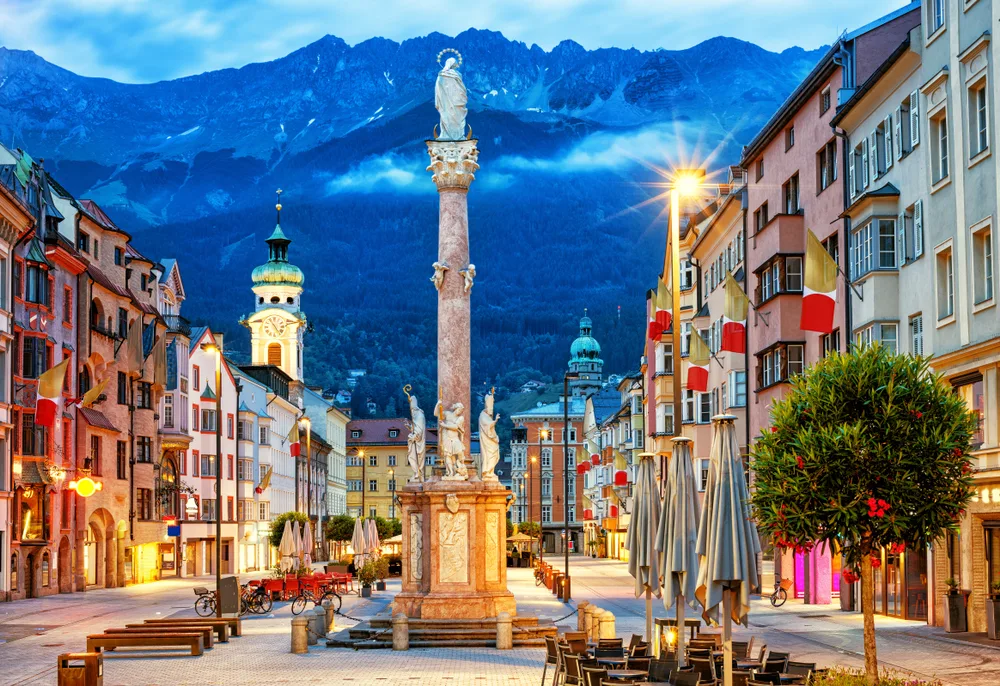
Boris Stroujko/Shutterstock
The cheapest time to visit Austria is during the winter (November-March), although when to get the best savings depends on where you visit. You can also find good deals in spring.
Vienna is the least expensive to visit in January, after the Christmas festivities are over. February is a bit more expensive because that is when ball season is in full swing, but you can still find good deals compared to the summer. During the winter, you can find hotels in the capital discounted by up to 40%.
Most small towns have even lower rates in the winter since it is the slow season. In Salzburg, some hotels offer discounts of over 50% in January! The exceptions are towns close to ski resorts, which enter their high season in the winter.
Spring is a good time to save money throughout the country as all regions enter a shoulder season. The savings may not be as dramatic as in the winter, but they are consistent as you can find discounts of 20-30% everywhere from the mountains to Vienna.
You can even go skiing for discounted rates in early spring. Places such as Ischgl offer discounted low season passes for March and early April that are up to 30 euros cheaper than high season passes.
If you’re flying to Austria, the most affordable airport to fly into is usually Vienna International Airport, which is well-connected to the rest of the country by train and bus. The least expensive months to fly to that airport are usually February, March, and April.
Least Busy Time to Visit Austria
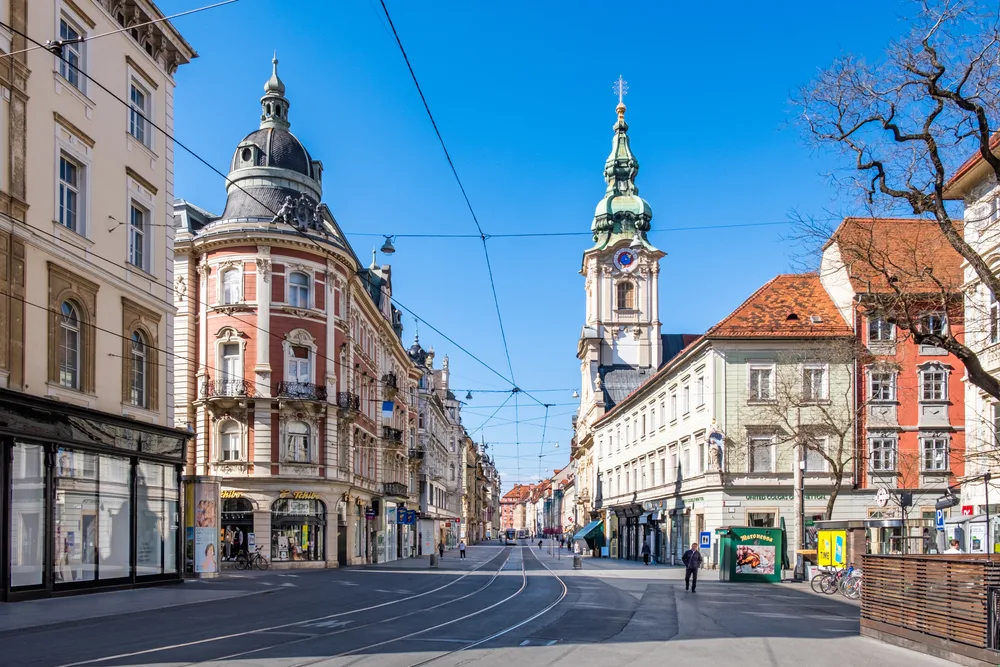
Rene Walter/Shutterstock
The crowds start to diminish in Austria as soon as the fall hits, but the absolute least busy time to visit is during the low season in winter, when you can have much of the country to yourself.
As soon as September begins and kids head back to school, things quiet down even at the most popular tourist attractions. Hotels in Vienna are still reasonably full, but you’ll find much shorter lines to popular attractions such as Schonbrunn Palace.
Experts recommend September or October for a city break since the crowds are less imposing, but the weather is still pleasant. Fall is also a good time to visit the mountains and smaller towns throughout Austria.
The weather is pleasant and crisp, with average temperatures in the mid-50s on the Fahrenheit scale (about 11-12 degrees Celsius).
Fall is not as rainy as summer, making for pleasant hiking weather, especially as the leaves begin to turn. Fall is a better choice for beating the crowds in Austria’s smaller towns, since many attractions shut down completely during the winter low season.
In bigger places such as Vienna, attractions are open all year round, so winter is a great time to visit to avoid the crowds. The exception is December, which is the Christmas season in Austria.
The country’s Christmas markets and celebrations are world-famous, attracting crowds. If you want to see the decorations, visit in late November. In Vienna, many of the top Christmas attractions, including the ice rink, are open until January.
Worst Time to Visit Austria

Calin Stan/Shutterstock
Weather-wise, the worst time to visit Austria is during the winter. However, summer is also becoming a bad choice, especially if you don’t like crowds.
Austria in the winter can be cold and dreary. Average daily high temperatures are usually around freezing (32 degrees Fahrenheit/0 degrees Celsius) while the nights are even colder. From November to March, the days are short and usually overcast.
However, the savings can cheer you up, and there are plenty of indoor attractions to keep you busy. Unless you’re passionate about skiing, this isn’t the best time to visit if you want to spend lots of time outdoors.
Trails are covered in snow in the mountains. Many smaller towns shut down attractions and tourist-related businesses during the off-season.
Although we said summer is the best time to visit Austria, it may not be the best choice for everyone. Summer in Austria is crowded and expensive, so budget travelers or those who hate waiting in line should try visiting another time.
Best Time to Visit Austria: Climate & Activities
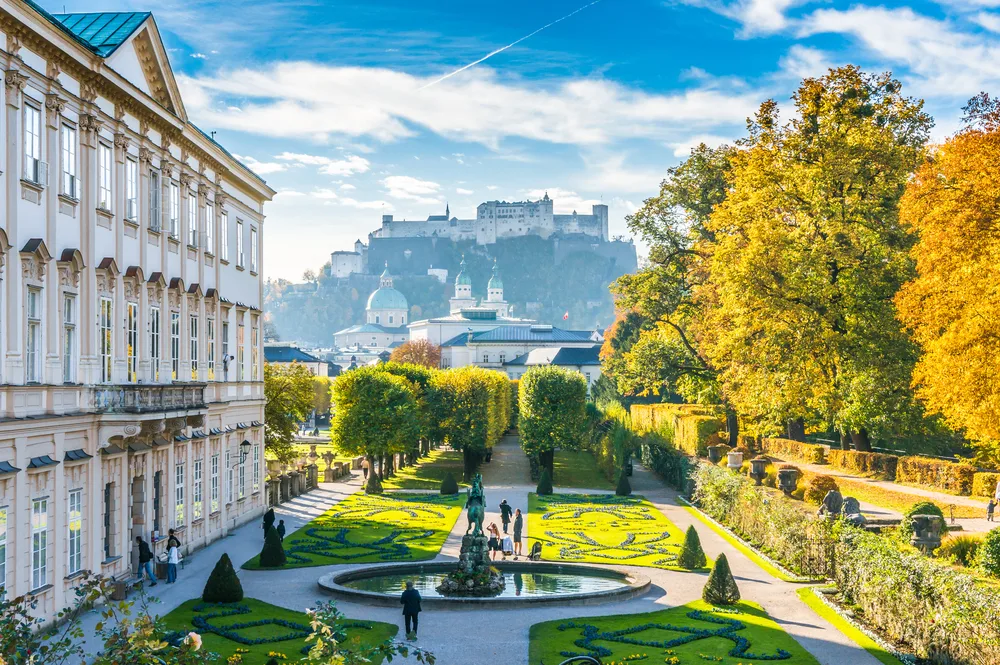
Canadastock/Shutterstock
Still unsure about the best time to visit Austria? Take a look at our summary of the weather and climate by month below:
January
January in Austria is cold, with snow-covered landscapes ideal for winter sports. Visit ski resorts like St. Anton or Kitzbühel for world-class skiing, enjoy the beautiful Christmas markets in Vienna and Salzburg, and experience the traditional Viennese Ball season.
February
February continues with chilly weather, perfect for winter sports in Tyrol and Vorarlberg. Attend the elegant Opera Ball in Vienna, explore the historic streets of Graz, and enjoy warming Austrian cuisine like Wiener Schnitzel and Apfelstrudel.
March
As winter slowly transitions to spring, March temperatures in Austria are still cool. This month is great for late-season skiing in places like Innsbruck, visiting the Schönbrunn Palace in Vienna, and exploring the blooming Alpine gardens.
April
In April, Austria has milder weather with temperatures around 6 to 15°C (43-59°F). Visit the vibrant city of Linz, explore the Wachau Valley for wine tasting, and experience the Salzburg Easter Festival.
May
May sees warmer temperatures from 11 to 20°C (52-68°F). It’s an excellent time for hiking in the Austrian Alps, exploring the lakes of the Salzkammergut region, and enjoying the Vienna Festival with its cultural performances.
June
June brings pleasant weather, with temperatures between 15 to 25°C (59-77°F). Explore Vienna’s outdoor cafes and parks, attend the Midsummer Night’s Concert by the Vienna Philharmonic, and visit the historic town of Hallstatt.
July
July is warm, with temperatures from 17 to 27°C (63-81°F). Enjoy the vibrant Bregenzer Festspiele (Bregenz Festival) on Lake Constance, take scenic boat trips on Lake Wolfgang, and explore the picturesque city of Innsbruck.
August
August continues with warm weather, offering temperatures from 17 to 27°C (63-81°F). Visit the Salzburg Festival for music and drama, explore the Baroque architecture of Graz, and enjoy hiking in the Hohe Tauern National Park.
September
As fall begins in September, temperatures in Austria range from 13 to 22°C (55-72°F). September is perfect for wine festivals in the Lower Austria region, exploring the historic city of Salzburg, and enjoying the autumn colors in the Vienna Woods.
October
October sees cooler temperatures from 7 to 15°C (45-59°F). Visit the traditional Almabtrieb cattle parades in Tyrol, explore the museums and art galleries of Vienna, and enjoy the colorful fall foliage in the Austrian Alps.
November
Fall temperatures in November range from 2 to 8°C (36-46°F). This month is ideal for visiting the thermal spas of Bad Gastein and exploring Vienna’s coffee culture.
December
In December, Austria experiences colder temperatures ranging from -1 to 5°C (30-41°F). December is festive with Christmas markets across Austria, especially in Vienna, Salzburg, and Innsbruck, and offers excellent skiing and Christmas concerts.
Frequently Asked Questions

Gokcentunc/Shutterstock
Here are a few of the most common questions people have asked about visiting Austria:
What is the best month to go to Austria?
The best month to go to Austria is September. The weather is still warm in early fall, and good for hiking, but there are far fewer people around than in the summer.
When is the least expensive time of year to visit Austria?
Winter is the least expensive time of year to visit Austria (November-March), except for the ski resorts. The exception is December, which is the Christmas season.
How many days in Austria is enough?
You need at least ten days to explore Austria. Spend at least four days in Vienna, then you want time to explore other cities such as Salzburg and the countryside.
Is Austria better in summer or winter?
For most activities, including hiking, Austria is better in the summer. For skiing, the country is better in the winter.
Which are the rainy months in Austria?
July and August are the rainiest months in Austria. The country receives a decent amount of rain throughout the year, but summer has the strongest storms.
So, What’s the Best Time to Visit Austria?
Summer is the best season to visit Austria thanks to the great weather and festivals, such as the famous Salzburger Festspiele. However, it is also expensive and crowded, so visit during one of the shoulder seasons to beat the lines or in winter for discounted hotel rates.
So, with so much to see and do and plenty of amazing times to visit, what are you waiting for — book your trip today and experience for yourself all that Austria has to offer. Happy travels!



